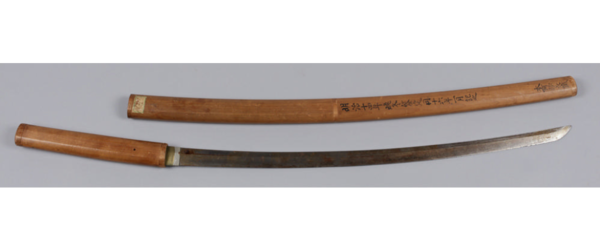
Eve
Members-
Posts
25 -
Joined
-
Last visited
Content Type
Profiles
Forums
Events
Store
Downloads
Gallery
Everything posted by Eve
-
Thank you so much - so helpful! They are indeed in a poor state and we do feel bad about it. We came into this museum recently. It's almost entirely volunteer staffed and has been since its inception in the 1930s. Unfortunately there just hasn't been money or knowledge - which is not to say there hasn't been care, it just hasn't always been the right kind. Also, not knowing a lot about nihonto, coupled with the time these were donated to the museum (30/40s) meant that nobody would have thought to restore them or clean them adequately in the first place. So they've been a bit neglected for sure. Someone had smeared them liberally with oil at some time but that has stained them, almost like watermarks. We can recommend a course of action for preservation and hopefully the museum can show them some love as the budget allows. I really appreciate your insight on these. We had deduced that the Rai Kunihisa was likely gimei. We have exactly one Japanese lady who lives in town so that gave us a start in our research. The photos I have put up do show the blade in the worst possible light too. 2379 was interesting and sent us down a rabbit hole - so much information on the saya but none matching the blade. Thanks for your info about the shape and hamon etc. 2381 - Interesting! Because of the plain nakago we had kind of guessed that it wasn't too interesting or old - shows how much we have to learn! Do you think it was made recently or is older?
- 10 replies
-
Ah you raise a really good point about the tsuka. You can probably see in the photos but it looks like there is another hole under the wrapping. I noticed it when I was taking the photos but I didn't connect the clues. That might also explain why the end of it was loose and came away so easily. Thanks for your help on this! All our nihonto have been in this collection since the 1930s/40s, so it's highly possible they were sold to unknowledgeable buyers at a time when it was quite trendy to own things from elsewhere. WWII also with many kiwis serving in J Force. It's all a bit of a mystery!
- 22 replies
-
- restoration
- wakizashi
-
(and 1 more)
Tagged with:
-
Thanks so much for all that info (and sorry for the typos). Hmm, interesting. The nakago looks snapped, to be honest, but of course that's just a guess on my part.
- 22 replies
-
- restoration
- wakizashi
-
(and 1 more)
Tagged with:
-
- 22 replies
-
- restoration
- wakizashi
-
(and 1 more)
Tagged with:
-
Hi Tom, Thanks for the info. Sorry to be a pain but can I please ask for more details? Like how you can tell? We're generalists trying our best to get this right and there's only so much help from reading articles on the net - we just don't have the experience.
- 10 replies
-
Thank you for the info. Could I please ask another question about the same sword - is there some reason the nagako would be snapped off like this one is?
- 22 replies
-
- restoration
- wakizashi
-
(and 1 more)
Tagged with:
-
Sorry for the late reply. I'll find the photos of the nagako on 2376 now and then post them. Our researcher had it as a type 98.
- 22 replies
-
- restoration
- wakizashi
-
(and 1 more)
Tagged with:
-
Yes, those are the catalogue numbers which were added some years ago (reversible, is a special museum product). Sorry late reply.
- 22 replies
-
- restoration
- wakizashi
-
(and 1 more)
Tagged with:
-
We're questioning how genuine it is. Any ideas on age etc? Thanks
- 10 replies
-
Hey all, I've created a couple of new posts with all our nihonto :-)
- 16 replies
-
- 22 replies
-
- restoration
- wakizashi
-
(and 1 more)
Tagged with:
-
- 10 replies
-
- 10 replies
-
- 1
-

-
Posted across several threads due to size limits....please see my profile for the rest.... As promised I'm sharing an overview of our small collection of nihonto. We're a small volunteer run museum in NZ. We don't know a ton about this collection and due to many factors much of the paperwork is missing, so we don't know the stories around how they came to be in the museum. At some time in the past the blades were all liberally coated in oil, we think maybe linseed oil. We've gently cleaned it off but as you can see it has stained the blades. They are all very much out of polish, which makes it very hard to see the hamon. We've done our best with the photos, to show the elements which would be useful in terms of ID. Full care for all of these nihonto is unfortunately outside the parameters of our current project, both time wise and budget wise. However, if the community on here identifies anything particularly special, we might be able to organise some special treatment. I hope this doesn't sound harsh. It's just that we are cataloguing and caring for an entire museum on a tiny budget. We really love these nihonto which is why we're sharing them here. So, any ID help is greatly appreciated, or just any general info or discussion at all. Every little bit of knowledge helps. Many thanks friends :-) Catalogue number 2379, previously discussed mismatched saya and blade:
- 10 replies
-
- 22 replies
-
- restoration
- wakizashi
-
(and 1 more)
Tagged with:
-
- 22 replies
-
- restoration
- wakizashi
-
(and 1 more)
Tagged with:
-
Posted across several threads due to size limits....please see my profile for the rest.... As promised I'm sharing an overview of our small collection of nihonto. We're a small volunteer run museum in NZ. We don't know a ton about this collection and due to many factors much of the paperwork is missing, so we don't know the stories around how they came to be in the museum. At some time in the past the blades were all liberally coated in oil, we think maybe linseed oil. We've gently cleaned it off but as you can see it has stained the blades. They are all very much out of polish, which makes it very hard to see the hamon. We've done our best with the photos, to show the elements which would be useful in terms of ID. Full care for all of these nihonto is unfortunately outside the parameters of our current project, both time wise and budget wise. However, if the community on here identifies anything particularly special, we might be able to organise some special treatment. I hope this doesn't sound harsh. It's just that we are cataloguing and caring for an entire museum on a tiny budget. We really love these nihonto which is why we're sharing them here. So, any ID help is greatly appreciated, or just any general info or discussion at all. Every little bit of knowledge helps. Many thanks friends :-)
- 22 replies
-
- 2
-

-
- restoration
- wakizashi
-
(and 1 more)
Tagged with:
-
Thanks very much everyone for your help. We're putting together a wee album to share all our Japanese blades. As Grey Doffin succinctly put it, small museums don't always have the know how. That's been the case here - a lot of good intentions and care but not the right kind. Also several mismatched blades and scabbards that probably came to NZ like that. We'll share our small collection and hopefully the experts here can let us know if any of them warrant further investigation. We don't have a ton of resources to throw at this and it's slightly outside the parameters of our project, but we all feel that if we have something special we would like to celebrate it. Thanks again and we'll get an album up soon :-)
- 16 replies
-
- 4
-

-
Help translating katana kanji needed (for another set!)
Eve replied to Eve's topic in Translation Assistance
Thanks guys! I'll note that it could be Kanefusa in both places but with a caveat that we can't be sure... -
Help translating katana kanji needed (for another set!)
Eve replied to Eve's topic in Translation Assistance
Great, thank you both. Here are a couple more photos (just taken on a cellphone this time), hopefully the quality is ok, and I think it's the right way up? -
Help translating katana kanji needed (for another set!)
Eve posted a topic in Translation Assistance
Hi everyone, I have another katana and saya with kanji I need translated... I'm pretty sure the saya says 'Kanefusa' but I can't work out the two on the pommel. Any help appreciated! Sarah -
Thanks everyone, we suspect the blade and saya aren't original to one another, hence the odd combinations of names.
- 16 replies
-
Does anyone know what the kanji on the tang say? Cheers
- 16 replies
-
Hi Steve, Thanks so much for that, very helpful. Is there a manufacture date noted on there? And what unit of measurement are shaku, sun and bu? Cheers
- 16 replies
-
Hey everyone, I'm working at a small museum in New Zealand where we have a collection of Japanese swords. I'm currently cataloguing a katana in its wooden saya that has kanji I'm hoping to get translated; the maker, date and location of manufacture, the class of blade if possible, and any other details noted. We've had some rough translations done by a Japanese local so we've been working off those thus far. I think we've narrowed down the appraisal to the Honami family during the Meiji period (1881 or 1883?) but I can't quite pinpoint which member specifically, possibly Chou Shoku or Kochu? We believe it was sold for 150 pieces of gold and the blade length is around 70.902cm. We also think the maker might have been born in Okayama, possibly the western region, within the Kamakura era (1192-1336), with the manufacture date around the late 1240s? These names came up in the translations but I haven't been able to ascertain who or what they are and how they fit into the blade's history: Kaneyasu Tamefusa Norifusa (this is written on the sticker presumably added by past museum staff) Katayama Norifusa Katayama ichimonji Any help translating/reading the kanji would be appreciated, thank you! Sarah
- 16 replies















